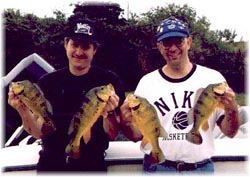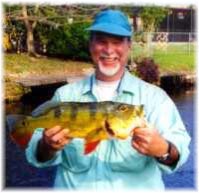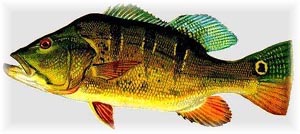|
|

FLORIDA'S BUTTERFLY PEACOCK BASS
by Jim Porter
We in south Florida have one of the finest fishing opportunities awaiting. All we have to do is go and partake of it. From approximately Ft. Lauderdale, south, the South American peacock bass thrives in the canals and watersheds that criss-cross the entire region. They are exciting, powerful fish that may just be the BEST fresh water game fish in the World.
 Butterfly peacock bass (Cichla ocellaris) were introduced into the man-made canals of southeast Florida to reduce abundant and underutilized exotic fishes, and to increase the socioeconomic value of fisheries resources in this highly urbanized area. This introduction represented the culmination of many years of research, which is important to realize, since our program and its success sets a precedent for others to judiciously consider exotic introductions as a management alternative.
Butterfly peacock bass (Cichla ocellaris) were introduced into the man-made canals of southeast Florida to reduce abundant and underutilized exotic fishes, and to increase the socioeconomic value of fisheries resources in this highly urbanized area. This introduction represented the culmination of many years of research, which is important to realize, since our program and its success sets a precedent for others to judiciously consider exotic introductions as a management alternative.
Butterfly peacock bass will primarily be limited to the man-made canals
of southeast Florida because they are incapable of tolerating water
temperatures less than 60oF (winter temperatures in "natural" Florida waters
nearly always drop below 60o)F. The combination of the box-cut shape, typical shoreline wind breaks of buildings and trees, inflow of groundwater and their geographic location in southeast Florida, makes these canals one of the most receptive habitats imaginable in North America for the exotic fishes that have been previously released illegally there.
 When butterfly peacocks were introduced in 1984, 11 other exotic fishes
had permanent populations in these canals. Average fish population estimates were 204 pounds per acre and 7,200 fish per acre, of which 38 percent by weight and 24 percent by number were exotic species. Spotted Tilapia (Tilapia mariae) dominated these fish populations, averaging more than 20 percent by weight and number of all fishes collected. This species also made up more than 70 percent by weight and by number of the fishes taken in individual canal samples. Data indicated these fish populations could support more predators (i.e., peacock bass) without detrimentally affecting important resident largemouth bass populations. Studies conducted since butterfly peacocks were introduced indicate they feed nearly exclusively on fish, and spotted tilapia have been found in more than 80% of the stomachs examined. Butterfly peacocks in Florida canals are considered to function as a 'complimentary' predator to largemouth bass, in a manner similar to the role this species plays in the man-made freshwater reservoirs of Hawaii.
When butterfly peacocks were introduced in 1984, 11 other exotic fishes
had permanent populations in these canals. Average fish population estimates were 204 pounds per acre and 7,200 fish per acre, of which 38 percent by weight and 24 percent by number were exotic species. Spotted Tilapia (Tilapia mariae) dominated these fish populations, averaging more than 20 percent by weight and number of all fishes collected. This species also made up more than 70 percent by weight and by number of the fishes taken in individual canal samples. Data indicated these fish populations could support more predators (i.e., peacock bass) without detrimentally affecting important resident largemouth bass populations. Studies conducted since butterfly peacocks were introduced indicate they feed nearly exclusively on fish, and spotted tilapia have been found in more than 80% of the stomachs examined. Butterfly peacocks in Florida canals are considered to function as a 'complimentary' predator to largemouth bass, in a manner similar to the role this species plays in the man-made freshwater reservoirs of Hawaii.
Butterfly peacocks have overwintered and reproduced successfully in
Florida canals since October 1984. Responses by anglers have been
overwhelmingly positive, and the presence of butterfly peacocks have improved local fish communities by reducing overabundant forage. The introduction of butterfly peacocks into southeastern Florida canals has proven to be very successful, and it is now the most sought after species by canal fishermen.
Beginning 1 July 1989, the Commission set a legal bag limit of two butterfly
peacock bass per fisherman per day, only one of which could be greater than 17 inches. A catch-and-release philosophy is strongly encouraged.
More than 10,000 butterfly peacocks and 2,600 largemouth bass were
caught during calendar year 1989 from an eight mile long canal with a surface area of only 100 acres. Total angling effort expended in this canal was estimated at 31,662 hours or 317 hours per acre, of which 33, 23 and 44
percent was spent fishing for butterfly peacocks, largemouth bass and all
other species combined, respectively. Fishing success for butterfly peacocks was excellent at 0.85 fish per hour, while largemouth bass were caught at a respectable 0.30 fish per hour. The direct economic value of the butterfly peacock canal fishery is estimated to be more than $1.4 million annually; and fishing as a whole in southeast Florida canals is valued in excess of $9.8 million annually.
This information indicates excellent canal catch rates for largemouth
bass continue in an area where fishing pressure is among the highest recorded in Florida. It is conceivable that largemouth bass benefit from less fishing pressure, with anglers redirecting a portion of their effort toward peacocks.
Most "harvestable" butterfly peacock bass (those greater than 10 inches)
are 12-14 inches in length and weigh about 1 1/2 to 2 pounds. Approximately
one-fourth of "harvestable" peacocks are greater than 14 inches, and the
current state record butterfly peacock weighs 7 pounds 6 1/2 ounces.
Ultimately, the state record is expected to exceed 9 pounds.
Reports of South American peacock bass weighing more than 10-12 lbs.,
always involve the speckled peacock (C. temensis) and not the butterfly peacock. The speckled peacock grows to sizes in excess of 25 pounds, but it doesn't become sexually mature until it is about three years old and weighs about 10 pounds. Although we have not given up completely on our original hope to create a trophy fishery for this species, its minimum age and large size at sexual maturity will limit its value in Florida canals where annual fishing pressure can exceed 300 hours per acre.
Based on our observations and fishermen responses, the introduction of
butterfly peacocks is judged to have been highly successful. It is important to keep this and other successful introductions in perspective, however, and to consider them only with utmost care and forethought. Furthermore, our studies confirm that urban, man-made canals can support good to excellent Sport-fishing opportunities in densely populated areas.
Most of the equipment and techniques you use for largemouth will catch some peacock bass, but few adjustments will increase your catch ratio considerably. I am not an expert on peacocks but the following tips seem to work.
- Forget the worms. You can catch a peacock with one, but it will be a rare event.
- If you are using live shiners, small ones seem to work better than large.
- Jerking motions near the surface seem to trigger the most strikes. A Blk/Gld Rapala seems to be the #1 lure for peacocks. Sluggos seem to work about as well as they do with largemouth's.
- You can keep fishing right through the brightest afternoon. Under bright conditions that would send a largemouth into deep cover, the peacock will be active and looking for a fight.
The following is an information sheet provided by the Florida Fish and Wildlife Conservation Commission.
BUTTERFLY PEACOCK
(Cichla ocellaris)
Common name - Butterfly peacock
Description - The body shape is similar to that of a largemouth bass. Body color is generally golden with three black vertical bars and a black spot with a silver halo on the caudal fin but have highly variable color patterns. In older fish, the bars tend to fade and may be completely absent in fish larger than 3 pounds.

Subspecies - It is a distinct species with no known subspecies.
Range - Butterfly peacocks were first stocked into the main coastal canal systems of southeast Florida in 1984. Low water temperatures prevent this species from becoming abundant outside of eastern Dade, Broward, and Palm Beach counties. The native range of butterfly peacock lies within the Amazon River basin of South America.
Habitat - Butterfly peacock were stocked in the fresh water sections of the major coastal canals in southeast Florida and support good fisheries. The many lakes, small ponds, rock pits, and lateral canals in eastern Dade and Broward counties also provide excellent opprtunities to catch butterfly peacock. They are frequently found in shady areas around bridges, culverts, and other structures. Canal junctions, bends, dead ends and fallen trees are also areas that concentrate butterfly peacock.
Spawning Habits - Spawning occurs in Florida from April through September with a peak in May and June. A female will select a flat, hard surface near shore and spawn between 4,000 and 10,000 eggs. Both parents care for the eggs and guard the young for several months. Male butterfly peacock develop a hump on their forehead while spawning and guarding young.
Feeding habits - Butterfly peacock prey primarily on fish. They feed only during daylight hours and rely on their exceptional speed to capture food.
Age and Growth - Butterfly peacock grow rapidly to 12-14 inches after which they become much heavier with each inch they add in length. A 17-inch fish will weigh approximately 3 pounds while a 19-inch fish will weigh up to 5 pounds. The largest butterfly peacock caught in Florida weighed 10.03 pounds and measured 23.3 inches. It is not known how long butterfly peacock typically live.
Sporting Qualities - This is a very popular sportfish for both boat and bank angler using a variety of tackle. Minnows are the preferred live bait. Top water lures, minnow imitating crank baits, and marabou jigs are popular with anglers using casting and spin casting tackle. Streamers, epoxy minnows and pencil poppers are favorites of fly fishers.
Eating Qualities - This is an excellent tasting fish with white, flaky meat and mild flavor.
State and World Records - The state record is 9.08 pounds and the current world record (caught in Florida) is 9.5 pounds. The International Game Fish Association recently added butterfly peacock to its list of world record game fishes eligible for line class records. This provides Florida anglers with one of the best opportunities ever to catch a world record fish."
|
Recommended sites by The Fishin' Tipster |
A common question that we get: "Is there somewhere close to get bait and tackle?" This is where we get our bait.

Pete and Tina Heinz / 9 South Mulberry St. / Fellsmere, FL 32948 / 772-571-9855
Get your site listed here
Let us help you drive more targeted traffic to your site.
|


Rank our Site
ęCopyright 2001-07 All rights reserved by Jim Porter, any reproduction, quotation or other use of this site or its elements is prohibited without the express written permission of Jim Porter
|
|
|







